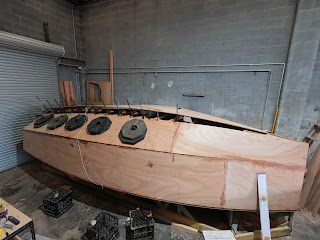For my rudder fabrication, I engaged Peter Kerr, a highly experienced professional boatbuilder who owns and operates Deagon Slipways north of Brisbane. I'm really pleased I engaged Peter, as he was able to share valuable knowledge on foil design and how they perform under different conditions.
The plywood kit includes a rudder template, and I originally intended to laminate 5-6 layers of plywood to create the rudder. Peter instead recommended that we fabricate the rudder out of solid timber to ensure it's more robust. Peter also recommended combining two different types of timber to achieve the best balance between strength and weight. The leading and trailing edge and the centre are thus "crows ash" (light colour timber), which is stronger and offers better impact resistance, and the rest is cedar, which is also renowned as an excellent boatbuilding timber.
The fabrication process involved laminating the timber sections into a single block, tracing the rudder template on the laminated block and a lot of shaping to get the right teardrop profile. Watching Peter shape the timber into a foil shape with a hand plane was like watching an artist at work. I was able to "apprentice" and observe at his workshop for a few days, which was also a really cool learning experience, and his tradesmen shared many useful tips on how to get the various jobs done as efficiently as possible. We finished off the rudded by using an epoxy-based timber sealant, fiberglassing it with quadraxial fiberglass cloth and fairing.




















